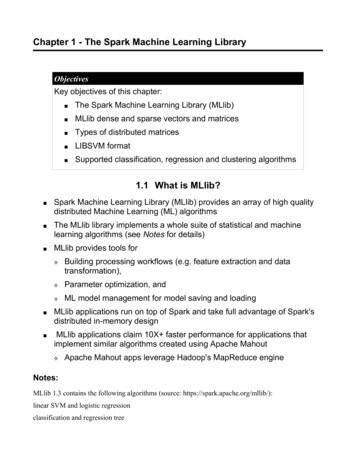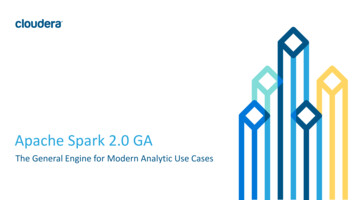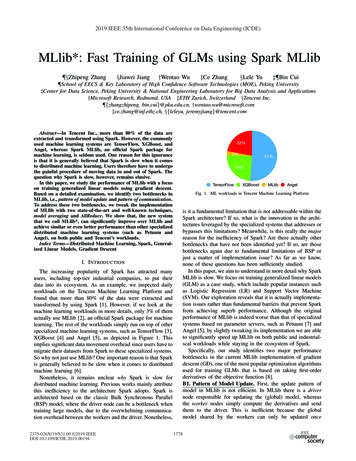
Transcription
Chapter 1 - The Spark Machine Learning LibraryObjectivesKey objectives of this chapter: The Spark Machine Learning Library (MLlib) MLlib dense and sparse vectors and matrices Types of distributed matrices LIBSVM format Supported classification, regression and clustering algorithms1.1 What is MLlib? Spark Machine Learning Library (MLlib) provides an array of high qualitydistributed Machine Learning (ML) algorithmsThe MLlib library implements a whole suite of statistical and machinelearning algorithms (see Notes for details)MLlib provides tools for Building processing workflows (e.g. feature extraction and datatransformation), Parameter optimization, and ML model management for model saving and loadingMLlib applications run on top of Spark and take full advantage of Spark'sdistributed in-memory designMLlib applications claim 10X faster performance for applications thatimplement similar algorithms created using Apache Mahout Apache Mahout apps leverage Hadoop's MapReduce engineNotes:MLlib 1.3 contains the following algorithms (source: https://spark.apache.org/mllib/):linear SVM and logistic regressionclassification and regression tree
random forest and gradient-boosted treesrecommendation via alternating least squaresclustering via k-means, Gaussian mixtures, and power iteration clusteringtopic modeling via latent Dirichlet allocationsingular value decompositionlinear regression with L1- and L2-regularizationisotonic regressionmultinomial naive Bayesfrequent itemset mining via FP-growthbasic statistics1.2 Supported Languages Java Python You will need to install the NumPy package as a dependency R Scala In our further discussion, we will be using Python to illustrate the mainconcepts and programming structuresNote: Spark version 1.6 (the latest in the 1.* version series) requires Java7 , Python 2.6 , R 3.1 , and Scala 2.10CanadaUnited States821A Bloor Street WestToronto, Ontario, M6G 1M11 866 206 4644getinfo@webagesolutions.com744 Yorkway PlaceJenkintown, PA. 190461 877 517 6540getinfousa@webagesolutions.com2
1.3 MLlib Packages MLlib is divided into two packages: spark.mllib Contains the original Spark API built on top of RDDsspark.ml Contains higher-level API built on top of DataFramesspark.ml is recommended if you use the DataFrames API which ismore versatile and flexibleFacilitates ML processing pipeline constructionNotes:Recently, the Spark MLlib team has started encouraging ML developers to contribute new algorithmsto the spark.ml package and at the same time are saying, "Users should be comfortable usingspark.mllib features and expect more features coming." l]1.4 Dense and Sparse Vectors MLlib supports local and distributed vectors and matrices Local vectors can be dense or sparse A dense vector is a regular array of doubles A sparse vector is backed by two parallel arrays: one for indices ofelements that are present, and the other for double values for thoseelements Values 1.0, 2.0, 0.0, 4.0 (a four element list) can be represented indense format asCanadaUnited States821A Bloor Street WestToronto, Ontario, M6G 1M11 866 206 4644getinfo@webagesolutions.com744 Yorkway PlaceJenkintown, PA. 190461 877 517 6540getinfousa@webagesolutions.com3
[1.0, 2.0, 0.0, 4.0]Same values in sparse format would be presented as (4, [0,1,3], [1.0, 2.0, 4.0])The first element is the size of the list; the vector [0,1,3] holds theindices of present elements; the third element (at the index 2) isabsent1.5 Labeled Point A labeled point is an object that represents label/category with a localvector (dense or sparse) of its propertiesUsed in supervised learning algorithms in MLlibA label is represented by a single double starting from 0.0 for the firstcategory, 1.0 for the second, etc., which make it possible to use them inboth regression and classification algorithms For binary classification cases, a label should be either 0.0 (for negativeclassification) or 1.0 (for positive classification)A label point is brought into code as an instance of the LabeledPointclass that carries the features (properties) and labels (categories) of thedata asset Features of a point are packaged as a vectorCanadaUnited States821A Bloor Street WestToronto, Ontario, M6G 1M11 866 206 4644getinfo@webagesolutions.com744 Yorkway PlaceJenkintown, PA. 190461 877 517 6540getinfousa@webagesolutions.com4
1.6 Python Example of Using the LabeledPoint Classfrom pyspark.mllib.linalg import SparseVectorfrom pyspark.mllib.regression import LabeledPoint# Features are represented by a dense feature vector:dataPointA LabeledPoint(0.0, [11.0, 2.2, 333.3, 4.444])# The dataPointA is labeled as belonging to category 0.0# Features are some measured properties of the data Point object# (e.g. size, speed, duration, breath rate, etc.# Features are represented by a sparse feature vector (elements atposition 1 and 2 in the feature vector are zeroed out):dataPointB LabeledPoint(1.0, SparseVector(4, [0, 3], [11.0, 4.444]))1.7 LIBSVM format LIBSVM is a compact text format for encoding data (usually representingtraining data sets)Widely used in MLlib to represent sparse feature vectorsA file in LIBSVM format is shaped as a matrix in which each line is aspace-delimited record that represents a labeled sparse feature (attribute /property) vectorThe layout is as follows: class label index1:value1 index2:value2 where the numeric indices represent features; values are separatedfrom indices via a colon ( ':' ) MLlib expects you to start class labeling from 0 Feature indices are one-based in ascending order (1,2,3, etc.); where afeature is not present in the data record, it is omitted from the record Note: After loading in your MLlib application, the feature indices areCanadaUnited States821A Bloor Street WestToronto, Ontario, M6G 1M11 866 206 4644getinfo@webagesolutions.com744 Yorkway PlaceJenkintown, PA. 190461 877 517 6540getinfousa@webagesolutions.com5
converted from one-based to zero-basedNotes:LIBSVM a library (and its data format) for support vector machines[http://www.csie.ntu.edu.tw/ cjlin/libsvm/faq.html].This resource [http://www.csie.ntu.edu.tw/ cjlin/libsvmtools/datasets/] contains a great number ofclassification, regression, multi-label and string data sets stored in LIBSVM format.1.8 An Example of a LIBSVM File0012232:11:11:16:18:16:18:1 14:1 21:1 23:1 25:19:1 11:1 13:1 18:1 20:15:1 15:1 18:1 21:1 23:19:1 12:1 14:1 16:1 24:113:1 21:1 22:1 27:1 30:18:1 10:1 15:1 17:1 21:11.9 Loading LIBSVM Files MLlib provides the MLUtils class, which, among many other things, offersthe method for loading a file in LIBSVM format:Example:from pyspark.mllib.util import MLUtilsdataSet MLUtils.loadLibSVMFile(sc, "data/mllib/libsvm data.dat") Note: The resulting dataSet object is an RDD with the records stored asLabledPoint objectsCanadaUnited States821A Bloor Street WestToronto, Ontario, M6G 1M11 866 206 4644getinfo@webagesolutions.com744 Yorkway PlaceJenkintown, PA. 190461 877 517 6540getinfousa@webagesolutions.com6
sc is the SparkContext reference1.10 Local Matrices Matrices in MLlib are stored as vectors with their dimensions provided asparameters to help with the matrix layout (see next slide for an example)Like with vectors, matrices can be dense or sparseData in a matrix is stored in the Compressed Sparse Column (CSC)format Example of CSC format 1.04.0 More specifically, data is serialized into a vector column-wiseIf the original matrix data layout is2.05.03.06.0Then the matrix data is packed in the resulting CSC-encoded vector asfollows:[1.0, 1.4, 2.0, 5.0, 3.0, 6.0]1.11 Example of Creating Matrices in MLlibimport org.apache.spark.mllib.linalg.{Matrix, Matrices}# Create a dense matrix ((1.0, 2.0), (3.0, 4.0), (5.0, 6.0)) shaped# in 3 rows, 2 columns; the first column will have values 1.0, 3.0,# and 5.0; the second column will have values 2.0, 4.0, and 6.0dm2 Matrices.dense(3, 2, [1, 2, 3, 4, 5, 6])CanadaUnited States821A Bloor Street WestToronto, Ontario, M6G 1M11 866 206 4644getinfo@webagesolutions.com744 Yorkway PlaceJenkintown, PA. 190461 877 517 6540getinfousa@webagesolutions.com7
Notes:The Python syntax of the dense() and sparse() methods of the Matrices class is as follows:static dense(numRows, numCols, values)Description: Create a DenseMatrixstatic sparse(numRows, numCols, colPtrs, rowIndices, values)Description: Create a SparseMatrix1.12 Distributed Matrices In MLlib, a distributed matrix is stored across a cluster of machines in oneor more RDDsIt uses long-typed (8-byte) row and column indices and double-typedvaluesMLlib has implemented the following types of distributed matrices so far:RowMatrix, IndexedRowMatrix, CoordinateMatrix, and BlockMatrix Note: You need to match your processing use case with the rightdistributed matrix type -- it is an advanced topic not reviewed here,please refer to the Spark original llib-data-types.html#distributedmatrixThe main idea behind the distributed matrices is based on splitting theunderlying matrix into a set of vectors and distribute the processing taskacross the cluster of machines using the parallelize() method of the SparkContext objectCanadaUnited States821A Bloor Street WestToronto, Ontario, M6G 1M11 866 206 4644getinfo@webagesolutions.com744 Yorkway PlaceJenkintown, PA. 190461 877 517 6540getinfousa@webagesolutions.com8
1.13 Example of Using a Distributed Matrix The following example shows how to use the RowMatrix typeIn the RowMatrix distributed matrix type, each row in an RDD is a localvectorfrom pyspark.mllib.linalg.distributed import RowMatrix# Create an RDD of vectorsv1 [1.0, 2.0, 3.0]v2 [4.0, 5.0, 6.0]rdd sc.parallelize([v1, v2])# Create a RowMatrix object from an RDD of local vectorsdistributedMatrix RowMatrix(rdd)1.14 Classification and Regression Algorithm According to Spark llib-classification-regression.html),MLlib supports the following algorithms for classification and regression inits spark.mllib package:CanadaUnited States821A Bloor Street WestToronto, Ontario, M6G 1M11 866 206 4644getinfo@webagesolutions.com744 Yorkway PlaceJenkintown, PA. 190461 877 517 6540getinfousa@webagesolutions.com9
1.15 Clustering According to Spark llib-clustering.html), MLlib supportsthe following algorithms for clustering in its spark.mllib package: K-means Gaussian mixture Power iteration clustering (PIC) Latent Dirichlet allocation (LDA) Bisecting k-means Streaming k-means1.16 Summary In this chapter we have reviewed the following topics: MLlib packages and supported languages The ways to create dense and sparse vectors and matrices Types of distributed matrices LIBSVM format Supported classification, regression and clustering algorithmsCanadaUnited States821A Bloor Street WestToronto, Ontario, M6G 1M11 866 206 4644getinfo@webagesolutions.com744 Yorkway PlaceJenkintown, PA. 190461 877 517 6540getinfousa@webagesolutions.com10
1.3 MLlib Packages MLlib is divided into two packages: spark.mllib Contains the original Spark API built on top of RDDs spark.ml Contains higher-level API built on top of DataFrames spark.ml is recommended if you use the DataFrames API which is more versatile and flexible Facilitates ML processing pipeline construction Notes: Recently, the Spark MLlib team has started encouraging ML developers .










